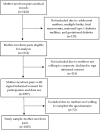Associations Between Maternal Meal Frequency Patterns During Pregnancy and Neonatal Anthropometric Outcomes: A Quantitative Cross-Sectional Study
- PMID: 40806021
- PMCID: PMC12348145
- DOI: 10.3390/nu17152437
Associations Between Maternal Meal Frequency Patterns During Pregnancy and Neonatal Anthropometric Outcomes: A Quantitative Cross-Sectional Study
Abstract
Background/Objectives: Maternal dietary behaviors, including meal frequency patterns, may influence fetal growth. This study examined the associations between maternal meal frequency patterns during pregnancy-categorized as structured, moderately irregular, or highly irregular-and neonatal anthropometric outcomes, including weight, length, head, chest, and abdominal circumferences, and Apgar score. A secondary objective was to assess whether maternal education and household income modify these associations. Methods: This cross-sectional study included 1025 mother-newborn pairs from a socioeconomically diverse Romanian cohort. Maternal meal frequency patterns were classified based on self-reported weekly consumption. Neonatal anthropometric outcomes were obtained from medical records. Multivariable linear regression models, adjusted for maternal and neonatal characteristics, assessed the associations between meal frequency patterns and birth outcomes. Interaction terms evaluated effect modification by maternal education and income. Results: Structured maternal meal frequency patterns were associated with a slight but significant reduction in neonatal length compared to highly irregular patterns (β = -0.36 cm; 95% CI: -0.68 to -0.04; p = 0.02). A borderline inverse association with birth weight was also observed (β = -63.82 g; 95% CI: -128.87 to 1.23; p = 0.05). No significant differences were found for other anthropometric indicators or Apgar score. Maternal education modified the association between moderately irregular patterns and chest circumference (β = 0.15 cm; 95% CI: 0.04 to 0.25; p = 0.003), while household income modified the association with abdominal circumference (β = 0.14 cm; 95% CI: 0.02 to 0.26; p = 0.02). Conclusions: Maternal meal frequency patterns were modestly associated with neonatal length, while socioeconomic factors modified specific anthropometric outcomes. These findings highlight the importance of considering social context in prenatal nutritional recommendations.
Keywords: birth weight; fetal growth; maternal nutrition; meal frequency; neonatal anthropometry; pregnancy; socioeconomic status.
Conflict of interest statement
The authors declare no conflicts of interest.
Figures
Similar articles
-
Intermittent auscultation (IA) of fetal heart rate in labour for fetal well-being.Cochrane Database Syst Rev. 2017 Feb 13;2(2):CD008680. doi: 10.1002/14651858.CD008680.pub2. Cochrane Database Syst Rev. 2017. PMID: 28191626 Free PMC article.
-
Antenatal dietary education and supplementation to increase energy and protein intake.Cochrane Database Syst Rev. 2015 Jun 2;(6):CD000032. doi: 10.1002/14651858.CD000032.pub3. Cochrane Database Syst Rev. 2015. PMID: 26031211
-
Incentives for increasing prenatal care use by women in order to improve maternal and neonatal outcomes.Cochrane Database Syst Rev. 2015 Dec 15;2015(12):CD009916. doi: 10.1002/14651858.CD009916.pub2. Cochrane Database Syst Rev. 2015. PMID: 26671418 Free PMC article.
-
Different treatment regimens of magnesium sulphate for tocolysis in women in preterm labour.Cochrane Database Syst Rev. 2015 Dec 14;2015(12):CD011200. doi: 10.1002/14651858.CD011200.pub2. Cochrane Database Syst Rev. 2015. PMID: 26662716 Free PMC article.
-
Multiple-micronutrient supplementation for women during pregnancy.Cochrane Database Syst Rev. 2017 Apr 13;4(4):CD004905. doi: 10.1002/14651858.CD004905.pub5. Cochrane Database Syst Rev. 2017. Update in: Cochrane Database Syst Rev. 2019 Mar 14;3:CD004905. doi: 10.1002/14651858.CD004905.pub6. PMID: 28407219 Free PMC article. Updated.
References
-
- Magnano San Lio R., Barchitta M., Maugeri A., Campisi E., Favara G., Granados C.O., La Mastra C., La Rosa M.C., Galvani F., Pappalardo E., et al. Sex Differences in Delivery and Neonatal Characteristics of New-Borns from the “MAMI-MED” Cohort. Front. Public Health. 2025;13:1498125. doi: 10.3389/fpubh.2025.1498125. - DOI - PMC - PubMed
-
- Wrottesley S.V., Lamper C., Pisa P.T. Review of the Importance of Nutrition During the First 1000 Days: Maternal Nutritional Status and Its Associations with Fetal Growth and Birth, Neonatal and Infant Outcomes Among African Women. J. Dev. Orig. Health Dis. 2015;7:144–162. doi: 10.1017/S2040174415001439. - DOI - PubMed
-
- Iacob O.M., Bacârea A., Ruța F.D., Bacârea V.C., Gliga F.I., Buicu F., Tarcea M., Avram C., Costea G.C., Sin A.I. Anthropometric Indices of the Newborns Related with Some Lifestyle Parameters of Women during Pregnancy in Tirgu Mures Region—A Pilot Study. Prog. Nutr. 2018;20:585–591. doi: 10.23751/PN.V20I4.7080. - DOI
LinkOut - more resources
Full Text Sources


